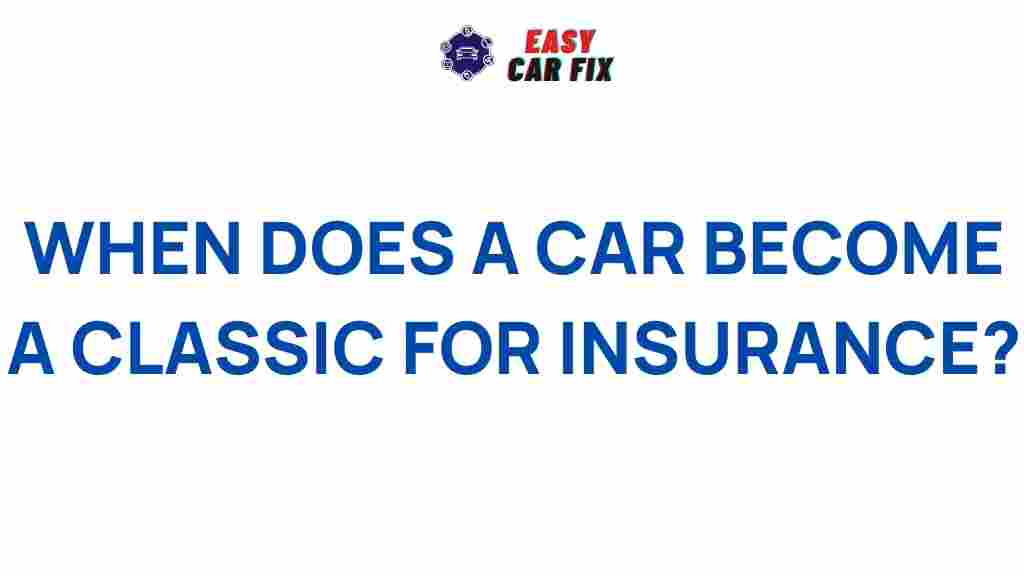Unveiling the Mysteries: When Does a Car Become a Classic for Insurance?
When it comes to classic cars, enthusiasts often find themselves navigating a complex landscape of insurance requirements, eligibility criteria, and valuation standards. But what exactly defines a classic car in the eyes of insurance companies? Understanding when a vehicle qualifies as a classic can lead to better coverage, lower premiums, and a more satisfying ownership experience. In this article, we’ll delve into the intricacies of classic car eligibility, criteria, and insurance policies.
What is a Classic Car?
A classic car is typically defined as a vehicle that is at least 20 to 25 years old, although definitions can vary by insurance company and region. However, simply being old isn’t enough. Several other factors come into play when determining whether a car qualifies as classic for insurance purposes.
Criteria for Classic Car Eligibility
To qualify as a classic car, a vehicle must meet specific criteria set forth by insurance companies and classic car organizations. Here are the primary factors that influence eligibility:
- Age: Most insurers consider a car to be classic if it is at least 20 years old, though some may require a minimum age of 25 years.
- Rarity: Limited production vehicles or those that are no longer manufactured tend to have a better chance of qualifying.
- Condition: A classic car should generally be in good condition, often restored to its original specifications or maintained to a high standard.
- Historical Significance: Vehicles that have historical importance or have made an impact on automotive history may be classified as classic.
- Modification: While modifications can affect eligibility, many insurers allow certain upgrades as long as they do not alter the car’s fundamental characteristics.
Valuation of Classic Cars
Valuation is a critical aspect of classic car insurance. Insurers need to determine the value of the vehicle to provide appropriate coverage. Here are some key points regarding classic car valuation:
- Market Research: Insurers often conduct market research to assess the current values of classic cars based on similar vehicles sold in the market.
- Appraisals: An official appraisal from a certified appraiser can provide a more accurate valuation and is often recommended for classic car owners.
- Documentation: Keeping records of restorations, repairs, and maintenance can help establish the car’s value.
Types of Coverage for Classic Cars
Classic car insurance policies differ significantly from standard auto insurance. Here are the typical types of coverage available:
- Agreed Value Coverage: This type of policy allows you to set a specific value for your classic car, ensuring you receive that amount in the event of a total loss.
- Stated Value Coverage: Similar to agreed value, but it allows the insurance company to pay up to the stated value minus depreciation.
- Liability Coverage: This is mandatory and covers bodily injury and property damage to others if you are at fault in an accident.
Requirements for Classic Car Insurance
When applying for classic car insurance, there are certain requirements that you must meet:
- Usage: Many classic car insurers require that the vehicle be used primarily for pleasure, shows, or parades, rather than daily commuting.
- Storage: Insurers may require that classic cars be stored in a garage or secure location when not in use.
- Driving Record: A clean driving record can be beneficial in securing better rates for classic car insurance.
Step-by-Step Process to Get Classic Car Insurance
Getting insurance for your classic car involves several steps. Here’s a guide to help you navigate the process:
- Determine Eligibility: Ensure your vehicle meets the eligibility criteria for classic car status.
- Research Insurers: Look for insurance companies that specialize in classic cars and compare their offerings.
- Gather Documentation: Collect all necessary documents, including title, registration, and any appraisal reports.
- Obtain Quotes: Request quotes from multiple insurers to compare rates and coverage options.
- Review Policy Details: Carefully review the terms of each policy, focusing on coverage limits, exclusions, and premiums.
- Finalize Your Choice: Select the insurance policy that best meets your needs and budget, then complete the application process.
Troubleshooting Common Issues with Classic Car Insurance
Even with all the right information, you may encounter challenges when insuring your classic car. Here are some common issues and how to address them:
- Higher Premiums: If you find yourself facing unexpectedly high premiums, consider increasing your deductible or shopping around for better rates.
- Denial of Coverage: If your vehicle is denied coverage, double-check the eligibility requirements and consider getting an appraisal to strengthen your case.
- Claims Process: If you encounter issues during the claims process, maintain clear documentation and communicate with your insurer to resolve disputes.
Conclusion
Understanding when a car becomes a classic for insurance purposes is essential for any vintage car owner. By familiarizing yourself with the eligibility criteria, valuation processes, and insurance options, you can ensure that your classic car is adequately protected. Whether you’re a seasoned collector or a first-time classic car owner, navigating the world of classic car insurance doesn’t have to be daunting.
For more information on classic car insurance policies and to explore your options, visit this helpful resource. And remember, always keep your vehicle’s condition and documentation up to date to make the insurance process as smooth as possible.
This article is in the category Basic Guides and created by EasyCarFix Team
